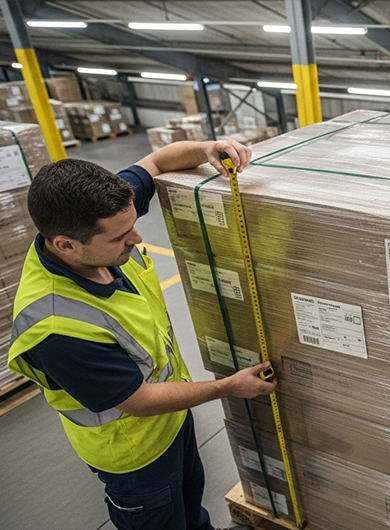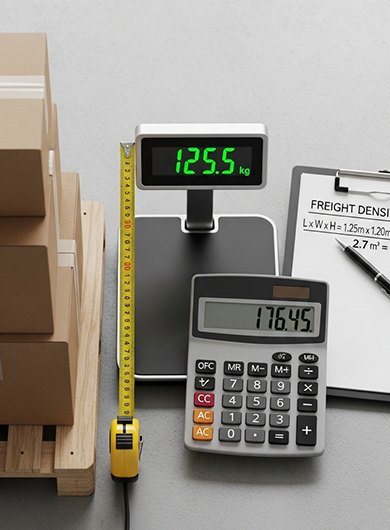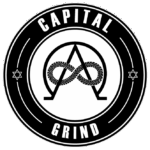Understand how LTL carriers classify freight using density, stowability, handling, and liability factors. Includes freight class chart 50-500, density calculator, packaging requirements for common business shipments, and tips to avoid surprise reclassification charges that can double your shipping costs on NYC-area LTL runs.
Less-than-truckload (LTL) shipping offers small businesses an affordable way to move freight without paying for a full truck. But one factor consistently catches shippers off guard: freight classification. Understanding how carriers classify your freight prevents surprise reclassification fees and ensures accurate quotes from the start.
What Is Freight Classification?
The National Motor Freight Traffic Association (NMFTA) maintains the National Motor Freight Classification (NMFC), a standardized system that assigns every type of commodity a freight class from 50 to 500. Your freight class directly impacts your shipping rate—the lower the class number, the lower your cost per hundredweight (CWT).
Carriers use four primary factors to determine freight class:
Density – Weight per cubic foot; denser freight ships cheaper Stowability – How easily freight fits with other shipments Handling – Special requirements like fragile, hazardous, or odd-shaped Liability – Risk of damage or theft affecting carrier’s insurance cost
Freight Class Chart & Examples
| Freight Class | Weight Per Cubic Foot | Examples |
|---|---|---|
| 50 | 50+ lbs/cu ft | Nuts, bolts, cast iron parts |
| 55 | 35-50 lbs/cu ft | Bricks, cement, hardwood flooring |
| 60 | 30-35 lbs/cu ft | Car parts, steel cables |
| 65 | 22.5-30 lbs/cu ft | Bottled beverages, books |
| 70 | 15-22.5 lbs/cu ft | Car accessories, food items |
| 77.5 | 13.5-15 lbs/cu ft | Tires, bathroom fixtures |
| 85 | 12-13.5 lbs/cu ft | Crated machinery, cast iron stoves |
| 92.5 | 10.5-12 lbs/cu ft | Computers, monitors, refrigerators |
| 100 | 9-10.5 lbs/cu ft | Boat covers, car covers, wine cases |
| 110 | 8-9 lbs/cu ft | Cabinet, framed artwork, table saw |
| 125 | 7-8 lbs/cu ft | Small household appliances |
| 150 | 6-7 lbs/cu ft | Auto sheet metal parts, bookcases |
| 175 | 5-6 lbs/cu ft | Clothing, couches, stuffed furniture |
| 200 | 4-5 lbs/cu ft | Auto sheet metal, aircraft parts |
| 250 | 3-4 lbs/cu ft | Mattresses, plasma TVs |
| 300 | 2-3 lbs/cu ft | Wood cabinets, tables, chairs |
| 400 | 1-2 lbs/cu ft | Deer antlers |
| 500 | <1 lb/cu ft | Bags of gold dust, ping pong balls |
How to Calculate Freight Density
Density determines class for most shipments. Calculate it in three steps:
Step 1: Measure Your Freight Measure length, width, and height in inches of each piece or pallet. Always use the longest points, including overhang, pallet dimensions, and packaging materials. Round up to the nearest inch.
Step 2: Calculate Cubic Feet Multiply Length × Width × Height, then divide by 1,728 (cubic inches per cubic foot).
Example: A pallet measuring 48″ × 40″ × 48″
- 48 × 40 × 48 = 92,160 cubic inches
- 92,160 ÷ 1,728 = 53.33 cubic feet
Step 3: Divide Weight by Volume Take total weight in pounds and divide by cubic feet.
Example: 500 lbs on 53.33 cubic feet
- 500 ÷ 53.33 = 9.37 lbs per cubic foot
- Freight Class 100 (9-10.5 lbs/cu ft range)
NMFC Codes vs. Freight Class
NMFC codes provide more specific classification than freight class alone. Each commodity has a unique NMFC number (6-digit code) that accounts for the item’s nature, packaging, and special characteristics. For example:
- NMFC 152600 – Furniture, office chairs, assembled
- NMFC 35540 – Electronics, computers, in cartons
- NMFC 80610 – Machine parts, steel, crated
When requesting LTL quotes, provide the NMFC code if you know it. This eliminates ambiguity and prevents reclassification. Many LTL carriers offer online NMFC lookup tools, or consult the official NMFC database (subscription required for full access).
Common Classification Mistakes That Cost Money
1. Measuring Only the Product, Not the Pallet Carriers measure the entire shipping unit, including pallets, crates, and packaging. A 40″ × 48″ product on a standard 48″ × 40″ pallet must be measured as 48″ × 40″ plus height including the pallet itself (typically 6″).
2. Underestimating Weight Always weigh freight on a certified scale. Estimating weight leads to reclassification and additional charges after pickup. Include packaging materials, pallets, crates, and any blocking or bracing lumber.
3. Ignoring Overhang If your product extends beyond the pallet edge, carriers measure to the furthest point. A 50″ item on a 48″ pallet is measured as 50″ wide, increasing cubic footage and potentially raising your class.
4. Failing to Declare Hazmat or Fragile Items Special handling requirements affect classification. Hazardous materials, refrigerated goods, and fragile items often jump to higher freight classes regardless of density. Failure to declare results in refused shipments or penalty fees.
We keep your freight moving efficiently.
Flexible Freight Options for Every Business
Custom freight services that move your business forward.
Packaging Tips to Optimize Freight Class
Maximize Density on Pallets Stack items efficiently to reduce overall cubic footage. A 48″ × 40″ pallet stacked 48″ high (53.33 cu ft) shipping 800 lbs yields 15 lbs/cu ft (Class 70). The same 800 lbs stacked 60″ high (66.67 cu ft) yields 12 lbs/cu ft (Class 85)—a higher class and higher cost.
Use Standard Pallet Sizes Carriers optimize trailer space for standard 48″ × 40″ GMA pallets. Odd-sized pallets waste space and may incur higher rates or accessorial charges for poor stowability.
Secure and Protect Your Freight Shrink wrap pallets with 4-6 wraps minimum, reinforcing corners. Use corner boards for stacked boxes. Proper packaging prevents shifting, reduces damage claims, and avoids carrier disputes over shipment condition.
Label Clearly Mark freight class, NMFC code, weight, and piece count on BOLs (Bills of Lading) and on the freight itself. Clear labeling speeds dock processing and reduces inspection delays.
What Happens During Reclassification
If your declared freight class doesn’t match actual density or characteristics, carriers reclassify the shipment and invoice the difference. Reclassification from Class 100 to Class 125 can increase costs by 20-30%. Inspect your freight carefully before quoting to avoid these charges.
Carriers typically discover discrepancies at the destination terminal when freight is cross-docked or dimensioned. You receive an invoice adjustment weeks after delivery. Dispute reclassifications with supporting documentation: scale tickets, photos, and measurements taken at origin.
LTL Pricing Beyond Freight Class
Class determines base rate, but total LTL cost includes:
Base Rate – Per hundredweight (CWT) by class and distance Fuel Surcharge – Percentage of base rate, adjusted weekly Accessorial Charges – Liftgate service ($75-150), inside delivery ($50-125), residential delivery ($75-125), appointment delivery ($50-100), limited access ($75-150)
Request detailed quotes showing all charges. A $200 base rate can become $400-500 with accessorials. Our LTL service through Capital Grind LTL provides transparent quotes with no hidden fees.
When to Use Freight Class vs. Dimensional Pricing
Some LTL carriers offer dimensional pricing that ignores traditional freight classes. They charge based on actual space consumed in the trailer (cubic feet) rather than density-based classes. Dimensional pricing benefits low-density freight shippers but may cost more for dense, heavy shipments.
Ask your carrier which pricing model applies. Our Capital Grind LTL service optimizes between class-based and dimensional pricing to ensure the lowest cost for your shipment profile.
Best Practices for Small Business Shippers
- Weigh and measure every shipment – Invest in a pallet scale and tape measure
- Keep NMFC codes on file – Build a reference library for your most-shipped items
- Photograph freight before shipping – Documentation protects against damage and reclassification disputes
- Use certified packaging – Proper palletization reduces damage and prevents carrier disputes
- Compare carriers – Freight class consistency matters, but carrier service quality varies
Regional LTL Service in NYC Metro
Our specialized freight services through Capital Grind LTL serve New York City (all five boroughs), Long Island, nearby New Jersey, and lower Connecticut with dedicated first- and final-mile access. We handle freight classification consultation at no charge—share your shipment details and we’ll verify class and NMFC codes before providing quotes.
Whether shipping office furniture from Manhattan to Connecticut, machine parts from Queens to New Jersey, or retail inventory across NYC, accurate freight classification ensures on-time delivery at the quoted price. Contact our logistics specialists for a consultation and transparent LTL quote.















Comments
miaqueen
It’s a great pleasure reading your post!
cmsmasters
Thanks.